Sizilien |
|
|
|
| Übersicht – Contents: | |
Diese Seite ist Teil des Projektes
Sizilien |
|
|
|
| Übersicht – Contents: | |
Flagge – Flag: |
|
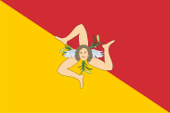 |
Flagge von Sizilien – flag of Sicily, Seitenverhältnis – ratio = 2:3, Quelle/Source: nach/by: Wikipedia (D), Dank an Marisa Citino |
historische Flaggen – historical Flags: |
|
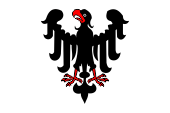 |
1258–1266, Banner von Manfred, König von Sizilien – Banner of Manfred, King of Sicily, Quelle/Source: nach/by: Wikipedia (EN) |
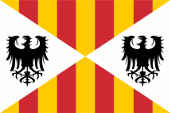 |
14./17. Jhd.–14th/17th cent., Flagge von Sizilien – flag of Sicily, vermutlich nur in den Zeiten unter der Herrschaft von Aragón oder später Spanien - probably only during the times under the rule of Aragón or later Spain Quelle/Source: nach/by: World Statesmen |
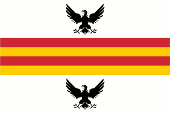 |
17./18. Jhd.–17th/18th cent., Flagge von Sizilien – flag of Sicily, vermutlich nur in den Zeiten unter der Herrschaft von Spanien - probably only during the times under the rule of Spain Quelle/Source: nach/by: World Statesmen |
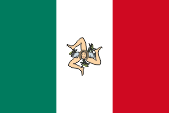 |
1848–1849, Flagge von Sizilien – flag of Sicily, Quelle/Source: nach/by: World Statesmen |
Bedeutung/Ursprung der Flagge – Meaning/Origin of the Flag: |
|
| "Die
Flagge Siziliens zeigt eine Triskele auf gelbrotem Grund. Sie existiert seit
der Sizilianischen Vesper 1282, als sich Sizilien gegen die Herrschaft Karls
I. von Anjou auflehnte. Die Farbe Rot symbolisiert die Stadt Palermo, die
Farbe Gelb stand für die Stadt Corleone, die landwirtschaftliches Zentrum
Siziliens war. Diese beiden Städte setzten sich für die Unabhängigkeit
Siziliens ein." Quelle/Source: Zitat/quote: Wikipedia (D) |
"The flag
of Sicily shows a yellow Triskele on a yellow-red background. It exists
since the Sicilian Vespers in 1282, when Sicily rebelled against the rule of
Charles I of Anjou. The color red symbolizes the city of Palermo, the color
yellow stands for the city of Corleone, which was an agricultural center of
Sicily. These two towns campaigned for the independence of Sicily." Quelle/Source: Zitat/quote: übersetzt/translated: Wikipedia (D) |
| Die frühen sizilianischen Flaggen ließen mit ihren roten und gelben Streifen auch die Zugehörigkeit des Landes zur Krone von Aragón erkennen. | The early Sicilian flags could get an insight, with their red and yellow stripes, that the land belongs also to the Crown of Aragón. |
| Ab 1734 wurde die Insel Sizilien vom Haus der Spanischen Bourbonen regiert, welches bis 1860 auch die Monarchen des Königreichs beider Sizilien stellte. Wahrscheinlich wurde auf Sizilien bis 1817 eine weiße Flagge (Weiß ist die Farbe der Bourbonen) verwendet, die das Wappen der Bourbonen zeigte. Ab 1817 wurden nur noch die Flaggen des Königreichs beider Sizilien verwendet. | From the year 1734, the island of Sicily was ruled by the House of the Spanish Bourbons. From this dynasty came also the monarchs of the Kingdom of the Two Sicilies until 1860. Probably, a white flag was used in Sicily until 1817 (White is the colour of the Bourbons), which showed the coat of arms of the Bourbons. From 1817, the flags of the Kingdom of the Two Sicilies were only used. |
| Von 1848 bis 1849 wütete in fast ganz Italien der Aufstand der Volksbewegung "Giòvane Itàlia" unter Mazzini und Garibaldi, die Monarchien waren oft kurz entmachtet. In dieser Aufstandsphase wurden in den italienischen Staaten (auch auf Sizilien) auch national-italienische Flaggen in Grün, Weiß und Rot verwendet. Die nationale italienische Erhebung endete jedoch in Uneinigkeit. | From 1848
to 1849 raged in almost all of Italy the uprising of the people's movement
"Giòvane Itàlia" under Mazzini and Garibaldi, the monarchies were often
shortly disempowered. In this phase of rebellion in the Italian States (even in Sicily) were often used national-italian flags in green, white and red. However, the Italian uprising ended in disagreement. |
| Quelle/Source: Volker Preuß | |
Zahlen und Fakten – Numbers and Facts: |
|
|
|
|
|
|
|
|
|
|
|
|
|
|
|
|
Landkarte der
Regionen Italiens – Map of the Regions of Italy: |
|
| Landkarte/Map: Volker Preuß |
Geschichte: |
|
Antike
· Sikaner und Sikuler siedeln auf der Insel, Phönizier, Griechen und
Karthager kommen später hinzu 480 v.Chr. · Abwehr einer Kathagischen Invasion auf der Insel Sizilien, jedoch zunehmender Einfluss Karthagos 264–201 v.Chr. · Erster Punischer Krieg, Sizilien wird römische Provinz 410 n.Chr. · Einfall der Westgoten ab 440 · die Vandalen überfallen die Insel nahezu jährlich 476 · Absetzung des letzten römischen Kaisers Romulus Augustulus, Ende des (West)Römischen Reiches, Sizilien gehört bis 493 zum Reich des Odoaker 493 · die Ostgoten besetzen die Insel 544 · Eroberung der Insel Sizilien durch Byzanz (Ostrom) 827 · Eroberung von Sizilien durch die Araber 1061–1091 · Eroberung Siziliens durch die Normannen, Bildung des Königreiches Sizilien 1130 · Unteritalien mit den langobardischen Fürstentümern, der Stadt Neapel, und den von den Byzantinern verlassenen normannischen Gebieten werden mit dem normannischen Königreich Sizilien vereinigt 1194 · das Königreich Sizilien kommt an das Haus Hohenstaufen 1266 · das Königreich Sizilien kommt an das Haus Anjou, Neapel wird ständige Hauptstadt des Reiches 1282 · "Sizilianische Vesper" – durch einen Volksaufstand kommt die Insel Sizilien als Königreich an das Haus Aragón, Unteritalien verbleibt als Königreich Sizilien (inoffiziell auch Königreich Neapel) bis 1442 bei Anjou 1442–1720 · zeitweise mit dem Königreich Neapel verbunden, zeitweise durch Frankreich besetzt, zeitweise unter der Herrschaft des Herzogs von Savoyen 1701–1714 · Spanischer Erbfolgekrieg 1714 · Friedensvertrag von Utrecht, das Königreich Neapel und das Königreich Sardinien kommen an die österreichischen Habsburger, das Königreich Sizilien kommt an Savoyen-Piemont 1719–1720 · von Österreich besetzt 1720 · Savoyen-Piemont tauscht mit Österreich Sizilien gegen Sardinien, das Königreich Sizilien kommt somit an das Haus Habsburg (Königreich Neapel-Sizilien) 1734 · das Haus Habsburg überlässt das Königreich Neapel-Sizilien dem Haus der Spanischen Bourbonen 1796 · Italienfeldzug Napoléons, Sizilien bleibt beim Haus Bourbon 1815 · Wiener Kongress, das Königreich Sizilien und das Königreich Neapel verbleiben bei den Spanischen Bourbonen 08.12.1816 · Gründung des Königreichs beider Sizilien unter den spanischen Bourbonen 1860 · Garibaldis Feldzug gegen das Königreich beider Sizilien, der König geht ins Exil, Garibaldi regiert als Diktator 1861 · das Königreich beider Sizilien muss sich dem Königreich Italien anschließen 1947 · Gründung der Region Sizilien als Verwaltungseinheit mit autonomem Sonderstatus |
History: |
|
Antiquity
· Sikanians and Sikulians settle on the island, Phoenicians, Greeks and
Karthagians arrive later 480 B.C. · rejection of an Kathagian invasion on Sicily Island, however growing influence of Karthago 264–201 B.C. · First Punic War, Sicily becomes a Roman province 410 A.D. · invasion of the Western Goth from 440 · the Vandals infest the island nearly annually 476 · dismissal of the last Roman emperor Romulus Augustulus, end of the (West)Roman Empire, Sicily belongs until 493 to the Empire of the Odoaker 493 · the Eastern Goth occupy the island 544 · conquest of Sicily Island by Byzanz (East Rome) 827 · conquest of Sicily by the Arabs 1061–1091 · conquest of Sicily by the Normans, establishment of the Kingdom of Sicily 1130 · Lower Italy with the Langobardian principalities, Naples Town, and the from the Byzantians left Norman territorities get united with the Norman Kingdom of Sicily 1194 · the Kingdom of Sicily comes to the House of Hohenstaufen 1266 · the Kingdom of Sicily comes to the House of Anjou, Naples becomes perpetual capital of the Empire 1282 · "Sicilian Vespers" – by a uprising comes the Island of Sicily as a kingdom to the House of Aragón, Lower Italy remains as Kingdom of Sicily (unofficial: Kingdom of Naples) until 1442 at Anjou 1442–1720 · temporarily connected to the Kingdom of Naples, temporarily occupied by France, temporarily under the rule of the Duke of Savoy 1701–1714 · Spanish heritage succession war 1714 · peace treaty of Utrecht, the Kingdom of Naples and the Kingdom of Sardinia come to the House of the Austrian Habsburgs, Kingdom of Sicily comes to Savoy-Piedmont 1719–1720 · occupied by Austria 1720 · the House of Savoy-Piedmont swaps with Austria Sicily in return for Sardinia, the Kingdom of Sicily comes in this way to the House of Habsburg (Kingdom of Naples-Sicily) 1734 · the House of Habsburg leaves the Kingdom of Naples-Sicily to the House of the Spanish Bourbons 1796 · Italy campaign of Napoléon, Sicily remains at the House of Bourbon 1815 · Vienna Congress, the Kingdom Sicily and the Kingdom of Naples stay with the Spanish Bourbons 8th of December in 1816 · establish of the Kingdom of Two Sicilies under the Spanish Bourbons 1860 · Garibaldi's campaign against the Kingdom of Two Sicilies, the king exiles, Garibaldi acts as dictator 1861 · the Kingdom of Two Sicilies has to join the Kingdom of Italy 1947 · establishment of the Sicily region as administrative unit with a special autonomous status |
| Quelle/Source: Meyers Konversationslexikon, Atlas zur Geschichte, Wikipedia (D), World Statesmen |
Ursprung des Landesnamens – Origin of the Country's Name: |
|
| Der Name "Sizilien" geht auf das Volk der Sikuler zurück, das in der Antike auf der Insel lebte. Als zweiten Namen trug die Insel die Bezeichnung "Trinacria", was "Die Dreispitzige" heißt. | The name "Sicily" goes back to the people of the Siculians, which lived on the island in the antiquity times. As a second name the island was called "Trinacria", what menas "The tricuspid". |
| Quelle/Source: Wikipedia (D) | |
|
Historische Staaten in Italien – Historical states in
Italy:
|
|
| Landkarte/Map: Volker Preuß |